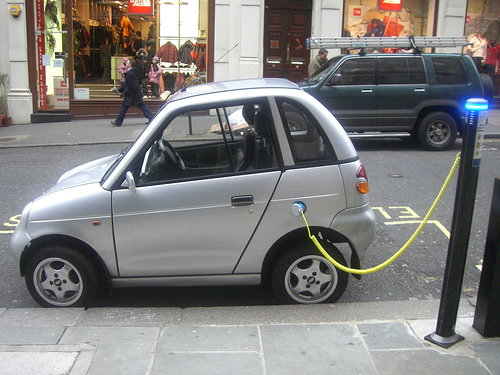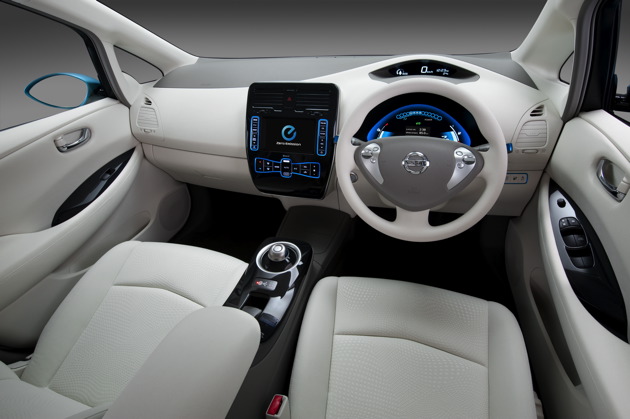 You open the door, climb in and settle behind the steering wheel. Everything about this car feels familiar. It even has that new car smell. You buckle your safety belt and start the engine, waiting for the roar of cylinders. Instead, there is a strange silence. Welcome to the electric car and a new age of driving.
You open the door, climb in and settle behind the steering wheel. Everything about this car feels familiar. It even has that new car smell. You buckle your safety belt and start the engine, waiting for the roar of cylinders. Instead, there is a strange silence. Welcome to the electric car and a new age of driving.
| Are electric cars safe? |
| Electric vehicles, though growing in popularity, still raise some eyebrows when it comes to the issue of safety.Car manufacturers are determined to prove to more skeptical motorists that electric cars are as safe as their gas-powered counterparts.For example, at the 2011 Detroit Auto Show, Volvo presented the results of its crash-tested, electric C-30 vehicle – literally. The damaged car was on display for all to see and proved that its integral parts remained undamaged.In January of 2011, AllCarsElectric.com in Palo Alto, Calif., reported that Mitsubishi released crash-test results for their European model, the i-MiEV, and noted that as soon as the car recognized it was hit, the high-voltage components of the power train immediately shut down. Also, the 88-cell lithium-ion battery remained undamaged.“A lot of the risks are the same between electric cars and regular types of vehicles from a liability standpoint,” says PCI’s Bob Passmore.“Things like bumper or fender damage are pretty much the same.”However, while EV’s don’t contain as many components that form the drive train and fuel system as gas-powered cars, they are lined with high-voltage cables that run between the motor, battery packs and charging connection. These components must remain intact even in a serious accident so that no part of the power train can cause a safety risk.
To that end, cables require added protection. Also, battery packs are reinforced. Crash sensors that normally control safety devices like airbags are also employed to cut all electrical power within milliseconds of an accident. Cutting power eliminates the risk of electrocution if a cable comes into contact with a driver or passenger. There have always been plenty of risks for drivers of conventional automobiles. The new age of the electric car may present manufacturers with new safety challenges to overcome. |
While electric cars offer several advantages over conventional gas-powered cars including significant air pollution reduction and relief for drivers concerned about increasing oil prices, there are some drawbacks.
According to State Farm, one of the main concerns drivers have about electric cars is the limited range of travel. Even though State Farm estimates that 94 percent of Americans travel less than 40 miles per day, potential buyers are concerned about this type of vehicle’s range – which is typically 100 miles per charge.
Electric cars can be more expensive compared to conventional internal combustion engine vehicles and hybrid cars due to the additional cost of their lithium-ion battery packs. Another downside is the lack of public and private recharging facilities.
There are a number of electric vehicles, or EV’s, on the road today including, the REVAi, Mitsubishi MiEV, Nissan Leaf, and perhaps the most eye-catching, the TESLA Roadster.
According to Cars Direct, pricing for 2010 electric car models ranges from $15,000 to $100,00 depending on the make and model. The TESLA Roadster can cost up to $109,000. In terms of maintenance costs, electric cars have an advantage over gas-powered cars. Electric cars cost approximately .2 per mile to operate versus .10 per mile for gas-powered cars.
However, because of their unique engineering, electric cars can carry higher repair costs and require non-standard parts that often are not available at regular repair shops.
Before going electric, drivers should consider the following information about insuring an EV. Auto insurance rates for cars are based on risk profiles and those take time to accumulate. Because electric cars are still relatively new, there is a lack of long-term underwriting data available.
“Basically, there really aren’t differences between insuring electric cars and any other type of car,” says Dick Luedke, spokesperson for State Farm.
“The one thing to keep in mind is that every make and model of vehicle is rated a little differently depending on its claims experience. “For electric cars, we haven’t really gathered enough claims experience to make any conclusions about the expense of insuring those specific types of vehicles.”

AllCarsElectric.com, owned by High Gear Media in Palo Alto, Calif., shares that assessment. A February 10, 2011 article noted that electric cars are not fully known by the insurance industry and that there is general uncertainty about electric cars and the technology that drives them. Additionally, there is no wide agreement on a depreciation model for electric cars.
“Fender or bumper damage is pretty much the same,” notes Bob Passmore, Senior Director of Personal Lines, Property Casualty Insurers Association of America (PCIAA). “The biggest difference between electric cars and regular cars are repairs for physical damage to the battery system and the drive train. There are fewer of these vehicles on the road, so it’s more expensive to repair those components.”
Drivers who are considering going electric should consult their car insurance provider to discuss adequate auto insurance. Electric cars could still require a specific policy compared with those needed for traditional vehicles.
Ironically, electric cars are not new. They first appeared at the dawn of the automobile age, outpacing gas-powered cars in popularity during the early years of the 20th century. Of course, that changed over time and gas-powered vehicles soon dominated the road. Today, with growing concerns about the environment and rising oil prices, could the electric car finally take the lead?













